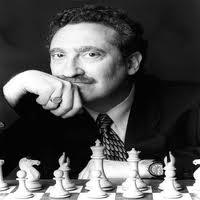
Pandolfini's Puzzler #50 - Askew in Skewers
Professor: Welcome back!
Zephyr: Thank you, Professor. We welcome your welcome.
Professor: I hope you enjoyed our class barbecue last week.
Thomas: I know I did.
Lucian: Me too. The hot dogs and hamburgers were great.
Rachel: I also liked the kebabs.
Ryan: Oh yes, those savory skewers.
Lucian: That’s not where we get the chess term “skewer," is it?
Zephyr: From spearing meats and vegetables on a stick at summer get-togethers? Yuck!
Professor: Actually, as yuck would have it, yes.
Thomas: So it is how we got the term “skewer”!
Professor: Pretty much.
Hale: It makes me think of possible future barbecues.
Professor: It makes me think of a possible lesson for today.
Lucian: What topic are you thinking of promoting today, Professor?
Professor: With such chess talk in the air, how about promoting promotion and queenly skewers?
Ryan: What are you driving at, Professor?
Professor: Driving at? It’s more like driving on or driving off.
Lucian: I think I’m confused.
Zephyr: I think someone usually is.
Professor: I think it’s time for our first elementary problem.
Question 1: How does White force a win?
Rachel: Elementary? You weren’t kidding. The problem is so simple it’s a slice of pie.
Zephyr: It’s only a cakewalk if you promote to the correct piece.
Thomas: I just realized it wouldn’t work if you chose a rook.
Professor: No, it wouldn’t. Let’s see how the class feels about our next piece of cake.
Question 2: How does White force a win?
Ryan: It seems un-puffed up to me.
Zephyr: It always does.
Lucian: Except when it doesn’t.
Thomas: But I guess you have to be careful to start with the best move.
Hale: Enough of the either/or puffery. How about giving us another problem?
Question 3: How can White unpin the g-pawn?
Ryan: That’s a neat trick.
Lucian: Yeah, I could have used it at the Marshall the other night against Zephyr.
Zephyr: Get out of here! The game was a dead draw.
Lucian: I had you crushed.
Zephyr: Are you kidding? I had a draw all the way.
Professor: Let’s not split hairs over a split point.
Hale: You win, Professor. May we see the next problem, please?
Question 4: Can White force a win?
Thomas: That problem looks so familiar.
Rachel: No fooling. It’s the same idea as the previous example.
Lucian: But we need the reinforcement.
Zephyr: Some of us need even more reinforcement.
Professor: Well, how about one more problem for the road? Or should I say one more problem for the roadblock?
Question 5: How does White avert a draw?
Lucian: Have I seen this position before?
Zephyr: I think you have, especially on the big screen.
Lucian: That’s right. It’s just like the end of the film "Searching for Bobby Fischer."
Professor: Well, yes and no. It’s a little different.
Lucian: How’s it different?
Zephyr: Well, that was a Hollywood ending.
Lucian: Yeah? So what?
Zephyr: So I don’t care what you say about our game the other night. I had a draw from beginning to end.
Answers below - Try to solve NM brucepandolfini's puzzles first!
ANSWER #50
Answer 1: White wins by 1. g8=Q b1=Q 2. Qa8+ (driving on to the b-file) Kb6 (or 2…Kb5) 3. Qb8+ (driving off the b-file, skewering king and queen).
If Black were to go first, then Black would win by the same motif.
Note that underpromoting to a rook wouldn’t work, since 1. g8=R? b1=Q 2. Ra8+ Kb7 stops the skewer check at b8.
With rooks instead of queens, the idea does work if the black king starts at a5 instead of a6. If Black goes first, the idea works if the white king starts on h4 instead of h3.
Answer 2: White must start with the right king move: 1. Kc8!. The winning line continues 1…e2 2. d8=Q e1=Q 3. Qa5+, driving off the a5-e1 diagonal and skewering king and queen.
Note that 1.Kc7? fails because it blocks the a5-d8 diagonal, obstructing White’s queen from getting to a5. Moreover, moving the white king to the e-file (1. Ke8? or 1. Ke7?) fails because it allows Black to queen with check.
Answer 3: The g-pawn is pinned but not for long. White has “a sac to get it back,” driving the black queen off the critical diagonal — and onto a losing square and a losing diagonal — with 1. Qc4+! (driving on) Qxc4 2. Bb1=Q+ (driving off), when the new queen wins the old one by a skewer.
Answer 4: Similar to Problem 3, White wins with a “sac to get it back”: 1. Qb1+! (driving on to the b-file) Qxb1 2. b8=Q+ driving off the b-file, then skewering the old king and queen with the new queen.
Answer 5: This winning variation begins with 1. Bd4!.
That winds up putting the black king on an exploitable diagonal (driving on). Afterward, with the a1-h8 diagonal temporarily obstructed, Black’s a-pawn will not be able to queen with check.
The result is that after 1…Kxd4 2. h8=Q a1=Q, the white king has a useful tempo. That is, the white king can then move off the a1-h8 diagonal (say 3. Kg8), unveiling a discovery and a winning skewer.
The latter part of that theme indeed is reminiscent of the concluding position in the film "Searching for Bobby Fischer."
Take note
There are various kinds of chess tactics. A lot of them fall into two overall classes: There are tactics of driving on and tactics of driving off.
Tactics that drive on typically force an enemy unit to occupy a bad square or line, so that the unit in question can be exploited.
Tactics that drive off generally compel an enemy unit to move off a particular square or line, making something else vulnerable.
RELATED STUDY MATERIAL
- Have a taste for more skewers? This video menu serves up a whole series about them.
- The skewer is only one flavor of chess tactic. Try this lesson series and become a tactics gourmet!
- Speaking of driving, this video from IM PlayfulSquirrel shows how to drive away defenders.
- BoundingOwl spices up her skewer with a tasty pin.

